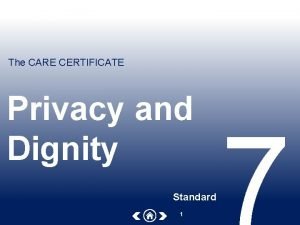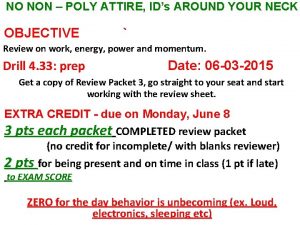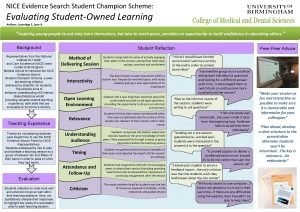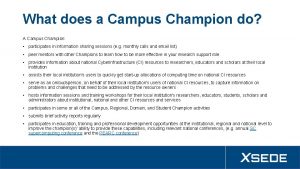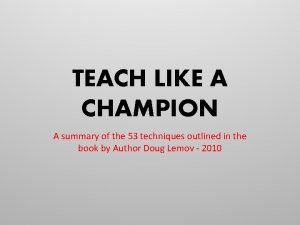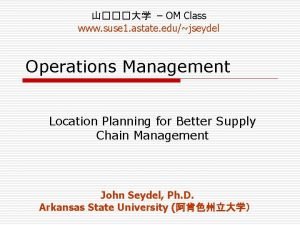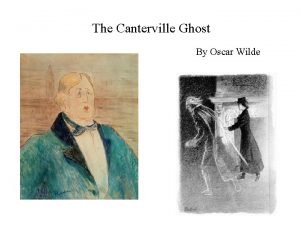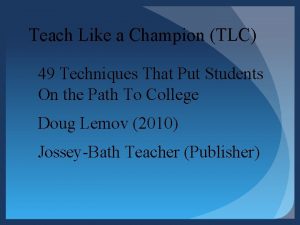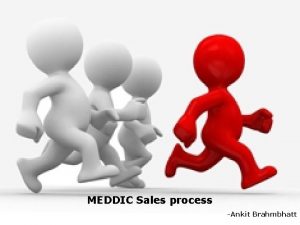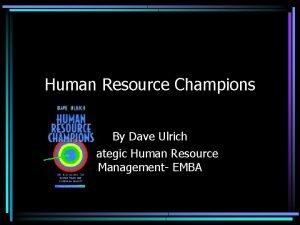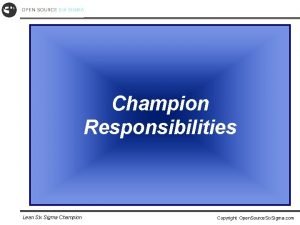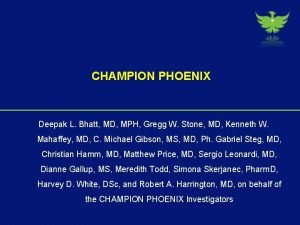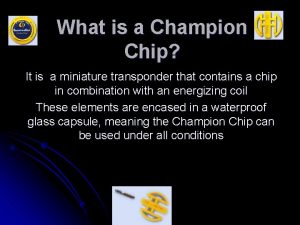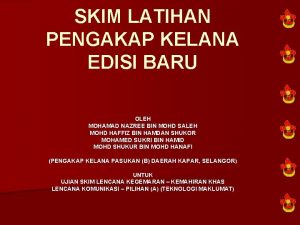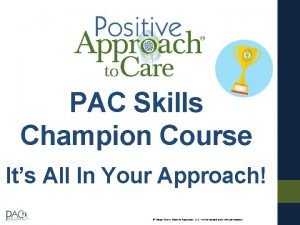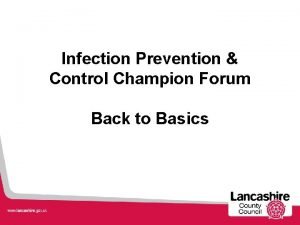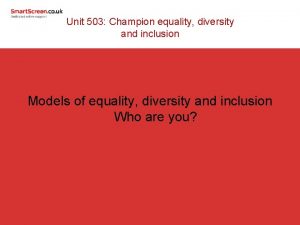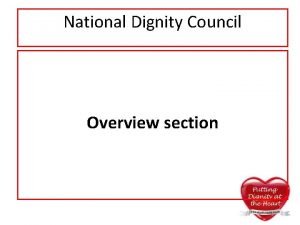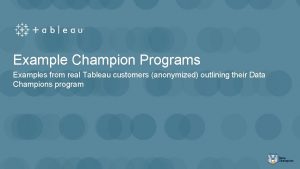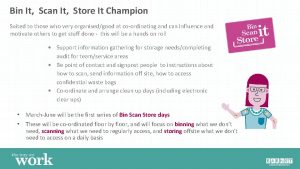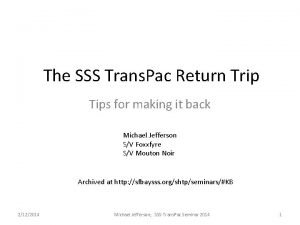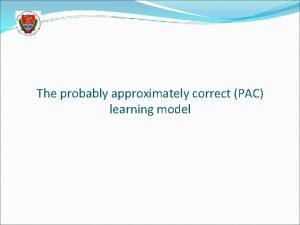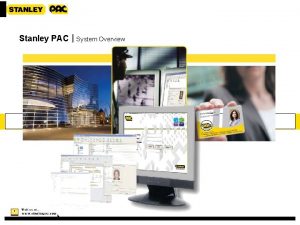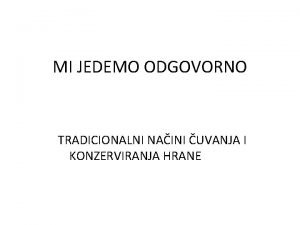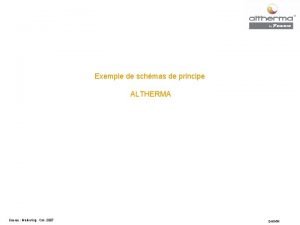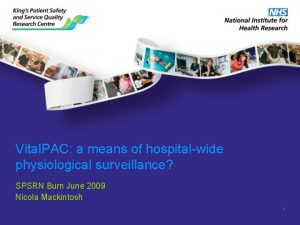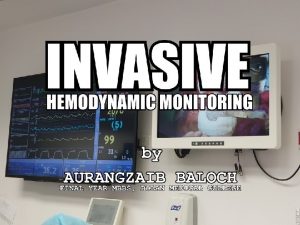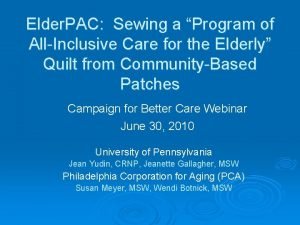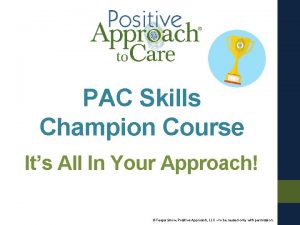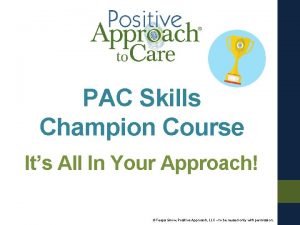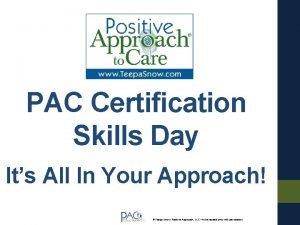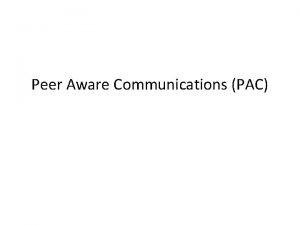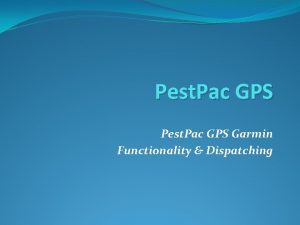PAC Skills Champion Course Its All In Your
































































- Slides: 64

PAC Skills Champion Course It’s All In Your Approach! © Teepa Snow, Positive Approach, LLC – to be reused only with permission.

Objectives for Today - Greet before you treat Practice PPA - sitting, standing, moving Use Positive Personal Connectors Connect with Hand-under-Hand connections Identify the sequence for cues that help Value the person that remains by using GEMS states © Teepa Snow, Positive Approach, LLC – to be reused only with permission.

Introductions – with a purpose - Pair up - You have 1 minute to introduce yourself to your partner and share one of the following about yourself: - Origin or meaning of your name - Where you come from and what you like or don’t like about it - Your favorite part of the day and why - Something that comforts you and how it helps - Then you will share a minute to introduce each other to the group, using what you learned © Teepa Snow, Positive Approach, LLC – to be reused only with permission.

Which part did you like better? - getting to know about the person OR - doing the introduction? © Teepa Snow, Positive Approach, LLC – to be reused only with permission.

So… Greet before you treat and Know your agenda, don’t show your agenda © Teepa Snow, Positive Approach, LLC – to be reused only with permission.

Introduction: PAC Beliefs • The relationship is MOST critical NOT the outcome of one encounter • We hold the KEY to make life better • People living with Dementia (PLw. D) are Doing the BEST they can • We must be willing to CHANGE ourselves, if we want to help © Teepa Snow, Positive Approach, LLC – to be reused only with permission.

Think… • Who do you have • Who, or which activity, is your most challenging to work with? • Who, or which activity, is the crack one? • Set your intention for the day with this in mind. © Teepa Snow, Positive Approach, LLC – to be reused only with permission.

Current Language Imagine you are at a table in a restaurant and from a nearby table you hear: “Well my friend, Mary, is demented now and so she really can’t do anything anymore. I mean how sad, her daughter has to do everything for her. ” My friend, Mary, has been diagnosed with Alzheimers. She is still able to do so many things, and yet both she and her daughter are having to adjust and make lots of changes. © Teepa Snow, Positive Approach, LLC – to be reused only with permission.

PAC Positive Language Person Living with Dementia (PLWD) Care Partner Assisting with… Doing WITH not TO Substitution NOT subtraction Unmet NEEDS GEMS® State Expressive Communication Validation © Teepa Snow, Positive Approach, LLC – to be reused only with permission.

PAC Skills Levels 1 - 4 Unaware Novice Proficient Accomplished Master © Teepa Snow, Positive Approach, LLC – to be reused only with permission.

Believe: It Takes TWO to Tango … or Tangle Learn to DANCE with our partner We must be willing to STOP & BACK OFF Being ‘right’ doesn’t necessarily translate into a good outcome © Teepa Snow, Positive Approach, LLC – to be reused only with permission.

© Teepa Snow, Positive Approach, LLC – to be reused only with permission.

Normal Brain with Alzheimers used with permission from Alzheimers: The Broken Brain, 1999 University of Alabama © Teepa Snow, Positive Approach, LLC – to be reused only with permission.

The person’s brain is dying © Teepa Snow, Positive Approach, LLC – to be reused only with permission.

Hippocampus BIG CHANGE Learning and Memory Center • • • Way Finding Learning and Memory Time Awareness © Teepa Snow, Positive Approach, LLC – to be reused only with permission.

How do we normally talk about getting a screening? -“I’m concerned about your mental health, let’s go to a doctor to assess…” -“You have been making mistakes like (insert list here)…I think we should screen for dementia. ” -“I just read this list of top ten signs you have dementia and I think you should go to the doctor right away…” © Teepa Snow, Positive Approach, LLC – to be reused only with permission.

Animal Fluency -Name as many animals as you can -Give one minute – (don’t highlight time limit) -Count each animal named (not repeats) -Establish Baseline versus Normal/Not Normal • OLD - 12 normal for > 65 and 18 for <65 • NEW - Compare you to you OVER time © Teepa Snow, Positive Approach, LLC – to be reused only with permission.

How could we talk about it? -“I know we are aging and I think it might be a good idea to do some baselines on our brains to keep track of how we are doing. Let’s go try. ” -“I have been noticing some changes, I am wondering if they might be due to some side-effects from the medications you are on. Could we check it out? ” © Teepa Snow, Positive Approach, LLC – to be reused only with permission.

Positron Emission Tomography (PET) Alzheimers Disease Progression vs. Normal Brains G. Small, UCLA School of Medicine. © Teepa Snow, Positive Approach, LLC – to be reused only with permission.

Positron Emission Tomography (PET) Alzheimers Disease Progression vs. Normal Brains Primitive Brain G. Small, UCLA School of Medicine. Primitive Brain © Teepa Snow, Positive Approach, LLC – to be reused only with permission.

Amygdalae: Dangerous Need Risky Dislike Alert/Aware © Teepa Snow, Positive Approach, LLC – to be reused only with permission. Like

Primitive Brain is in Charge of: Survival – • Autonomic protective – fright, flight, fight + hide or seek • Pleasure seeking – meeting survival needs & finding joy Thriving – Running the Engine • Maintain vital systems (BP, BS, O 2 sat, Temp, pain) • Breathe, suck, swallow, digest, void, defecate • Circadian rhythm • Infection control Learning New and Remembering: • Information • Places (spatial orientation) • Passage of Time (temporal orientation) © Teepa Snow, Positive Approach, LLC – to be reused only with permission.

Executive Control Center Left Right • • • Left Impulse Control Be Logical Make Choices Start-Sequence. Complete-Move On Self Awareness See Others’ Point of View Right © Teepa Snow, Positive Approach, LLC – to be reused only with permission.

Vision Center – BIG CHANGES © Teepa Snow, Positive Approach, LLC – to be reused only with permission.

Vision Changes With each new level of vision change, there is a decrease in safety awareness. 1. Less Peripheral Awareness 2. Tunnel Vision 3. Binocular Vision 4. Object Use Confusion 5. Monocular Vision 6. Limited Visual Regard © Teepa Snow, Positive Approach, LLC – to be reused only with permission.

Understanding Language – BIG CHANGE © Teepa Snow, Positive Approach, LLC – to be reused only with permission.

Hearing Sound – Not Changed © Teepa Snow, Positive Approach, LLC – to be reused only with permission.

Scale of Emotional States: Amygdalae Distress Low – Amygdala Active Alert Medium – Amygdala Stressed At Risk High – Amygdala in Control, Endangered Irritated Bothered Angry Frustrated Furious Enraged Dissatisfied Blue Sad Unhappy Devastated Hopeless Missing something Missing freedom/control Lonely – Disconnected Confined/restricted Abandoned – Isolated Imprisoned Nervous Anxious Scared Worried Terrified Panicked Disengaged Antsy Bored Roaming Useless –Purposeless Frantic © Teepa Snow, Positive Approach, LLC – to be reused only with permission.

Scale of Emotional States: Amygdalae Pleasure Low – Amygdala Active Liking It Medium – Amygdala Stressed Wanting to Do More High – Amygdala in Control Need Something Excited Hyped Up Hysterical Happy Boisterous Slap Happy or Delirious Connected or In Control Can’t seem to get “it” Controlling or Clingy Energized Rev’ed Racing Around Full of Purpose Committed Demanding Others Get Purpose © Teepa Snow, Positive Approach, LLC – to be reused only with permission.

Global Deterioration Scale - 1 – No cognitive decline - 2 – Very mild cognitive decline - (Age Associated Memory Impairment) - 3 – Mild cognitive decline - (Mild Cognitive Impairment) - 4 – Moderate cognitive decline - (Mild Dementia) - 5 – Moderately severe cognitive decline - (Moderate Dementia) - 6 – Severe cognitive decline - (Moderately Severe Dementia) - 7 – Very severe cognitive decline - (Severe Dementia) - So what can they do? The scale doesn’t address that? © Teepa Snow, Positive Approach, LLC – to be reused only with permission.

GEM® Dementia Abilities Based on Allen Cognitive Levels • A Cognitive Disability Theory – OT based • Creates a common language and approach to providing: üEnvironmental support üCaregiver support and cueing strategies üExpectations for retained ability and lost skill üPromotes graded task modification • Each Gem state requires a special ‘setting’ and ‘just right’ care üVisual, verbal, touch communication cues • Each can shine • Encourages in the moment assessment of ability and need üAccounts for chemistry as well as structure change © Teepa Snow, Positive Approach, LLC – to be reused only with permission.

The GEMS®… Sapphires True Blue – Healthy Brain Diamonds Clear/Sharp – Routines & Routines Rule – Change is HARD Emeralds Green/On the Go with Purpose– Naturally Flawed Ambers Caught In a moment of time – Caution Required Rubies Deep & Strong – Others stop seeing what is possible Pearls Hidden in a Shell – Beautiful Moments to Behold © Teepa Snow, Positive Approach, LLC – to be reused only with permission.

A Positive Framework… seeing GEMS Sapphires – True Blue – Slower BUT Fine Diamonds – Repeats & Routines, Cutting Emeralds – Going – Time Travel – Where? Ambers – In the moment - Sensations Rubies – Stop & Go – Big Motions or Still Pearls – Hidden in a Shell - Immobile © Teepa Snow, Positive Approach, LLC – to be reused only with permission.

Show Tell Touch See Understand Feel © Teepa Snow, Positive Approach, LLC – to be reused only with permission.

What do you notice? 1. Pace 2. Visual Cues 3. Verbal Cues 4. Physical Cues v. What do you want to try? © Teepa Snow, Positive Approach, LLC – to be reused only with permission.

INPUT – Data In: 1. What you see 2. What you hear 3. What you feel/ touch 4. What you smell 5. What you taste © Teepa Snow, Positive Approach, LLC – to be reused only with permission.

Visual Cue Options - Signs Pictures Props or Objects Gestures Facial Expressions Demonstrations © Teepa Snow, Positive Approach, LLC – to be reused only with permission.

How Can We GIVE Information? Visual Cues - Show Verbal Cues - Tell Tactile Cues - Touch © Teepa Snow, Positive Approach, LLC – to be reused only with permission.

Practice §Visual Cues © Teepa Snow, Positive Approach, LLC – to be reused only with permission.

3 Zones of Human Awareness Public Space – more than 6 ft away • Visual Awareness and Social Interactions Personal Space – 6 ft to arm’s length • Friendly and Personal Conversations Intimate Space – within arm’s reach • Intimate Touch or Connections © Teepa Snow, Positive Approach, LLC – to be reused only with permission.

Practice: § PPA using the 3 zones as a guide: - Get into visual range (public space), pausing at the edge of personal space at approximately 2 arms length away - Greet with your hand held still by your face and smile - Slowly extend hand for a handshake - After the person you are approaching gives permission by extending their hand, move slowly into a handshake (entering intimate space) - Move from handshake to Hand-under-Hand® position - Move from the front to the side, getting into a supportive stance - Get to or below their eye level - Use a PPC (Positive Personal Connection) or PAS (Positive Action Starter) phrase © Teepa Snow, Positive Approach, LLC – to be reused only with permission.

Practice §PPA using the 3 zones as a guide… © Teepa Snow, Positive Approach, LLC – to be reused only with permission.

Core PPATM Ingredients and a Basic Recipe: - Observe visually - Seek visual regard - Offer verbal greeting - If visual and verbal reactions are OK, progress (if not, pause) - Offer friendly social contact: hand shake, eye contact - If offer is accepted, transition into supportive position, at a matched height (if not, pause) - Transition into Hand-under-Hand® positioning, if accepted, to sustain connection (if not, pause and release and step-move back) - Offer a PPC, if accepted, transition to a PAS (if not, pause and try again) © Teepa Snow, Positive Approach, LLC – to be reused only with permission.

Step 1: Stop moving 6 ft out Pause at the Edge of Public Space • Stop moving - 6 ft • Let the person NOTICE you in public space ( give them time to do this) • Acknowledge the person’s OWNERSHIP of personal space • Respect their space! © Teepa Snow, Positive Approach, LLC – to be reused only with permission.

Step 2: Greet-Give ‘hi’ sign Bring flat, open palm up near face • Visual cue to look at you Say “HI!” and use preferred name, if known • Verbal cue to look at you Look Friendly • Smile • Make eye contact © Teepa Snow, Positive Approach, LLC – to be reused only with permission.

Step 3: Say name, offer hand Seek permission to enter PERSONAL SPACE SHOW person what you want to do Watch for their reaction/response If there’s hesitation ○ STAY in PUBLIC space ○ Turn your body SIDEWAYS – supportive stance ○ See what happens next – no better? hold back © Teepa Snow, Positive Approach, LLC – to be reused only with permission.

Step 4: Move slow Move Slowly toward the person • While offering your hand in greeting • Smile and look friendly • 1 second = 1 step • Respect SLOWED processing time • Decreased ability to do two things at one time © Teepa Snow, Positive Approach, LLC – to be reused only with permission.

Step 5: Move into SUPPORTIVE stance Shift toward dominant side – hand shake side Turn your TRUNK sideways to the person Stay at ARM’S length Keep face & chest back © Teepa Snow, Positive Approach, LLC – to be reused only with permission.

Step 6: Hand-under-Hand™ Go into Hand-under. Hand™ from a normal handshake • Provides protection for them AND you • Connects you with them while giving them a sense of control © Teepa Snow, Positive Approach, LLC – to be reused only with permission.

Step 7: Move to side, get low Get to their level • SIT, kneel, or squat Respect INTIMATE space Allow eye contact with limited visual field • Get focus on your face not your chest or middle © Teepa Snow, Positive Approach, LLC – to be reused only with permission.

Step 8: Make connection Make friendly statement Wait for a response or acknowledgement Be sure you have a connection before you start your care © Teepa Snow, Positive Approach, LLC – to be reused only with permission.

Step 9: Deliver a Message Give visual cues first Offer verbal information next Use touching last AND only if the person is aware of your plan © Teepa Snow, Positive Approach, LLC – to be reused only with permission.

If You Can’t Get LOW… • Stay greater than arm’s length away • Use Verbal Connections • If it’s not working, get a seat © Teepa Snow, Positive Approach, LLC – to be reused only with permission.

Positive Physical Approach™ To the tune of Amazing Grace Come to the front, Go slow Get to the side, Get low Offer your hand, Call out their name Then wait…. . If you will try, then you will see How different life can be For those you’re car-ing for. © Teepa Snow, Positive Approach, LLC – to be reused only with permission.

Positive Personal Connections (PPC) 1. Greet or Meet-introduce yourself and use their preferred name Hi___I am ___ or I am___ and you are? 2. Say something NICE Indicated something about them of value 3. Be friendly - Share about you then leave a blank 4. Notice something – Point out something in the environment 5. Be curious – Explore a possible unmet like, want or need © Teepa Snow, Positive Approach, LLC – to be reused only with permission.

Positive Action Starters (PAS) 1. Help – Be sure to compliment their skill in this area, then ask for help. 2. Try – Hold up or point to the item you would like to use, possibly sharing in the dislike of the item or task, “Well, let’s try this. ” 3. Choice – Try using visual cues to offer two possibilities or one choice with something else as the other option. 4. Short and Simple – Give only the first piece of information, “It’s about time to (first task). ” 5. Step by Step – Only give a small part of the task at first, “Lean forward. ” © Teepa Snow, Positive Approach, LLC – to be reused only with permission.

Person Being Approached - Practice using the abilities of someone in an Emerald state - Binocular vision – start off looking downward - Vague in language – missing ¼ words - Better with step by step cues - Take some time to process – count to 3 in your head - Try to provide your partner with honest and authentic feedback considering you were in Emerald state. © Teepa Snow, Positive Approach, LLC – to be reused only with permission.

But…what if? 1. The person is standing up 2. You enter their room 3. The person approaches you/ starts the interaction 4. The person is blind 5. The person is at a table 6. The person is in a corner or facing a door 7. The person is asleep 8. The person doesn’t offer their hand back 9. The person tells you to stay out © Teepa Snow, Positive Approach, LLC – to be reused only with permission.

Top Five Human Needs and Emotional Indicators of Distress Five Expressions of Emotional Distress Five Human Needs Angry Intake irritated – angry – furious Hydration, nourishment, meds Sad Energy Flow dissatisfied – sad – hopeless tired or revved up directed inward or outward Lonely Output solitary – lonely – abandoned/trapped Urine, feces, sweat, saliva, tears Scared Comfort anxious – scared – terrified 4 Fs and 4 Ss Lacking Purpose PAIN Free!!! disengaged – bored – useless Physical, emotional, spiritual © Teepa Snow, Positive Approach, LLC – to be reused only with permission.

Sensory Strip Motor Strip White Matter Connections BIG CHANGES Right Left Automatic Speech Rhythm – Music Expletives PRESERVED Formal Speech & Language Center HUGE CHANGES © Teepa Snow, Positive Approach, LLC – to be reused only with permission.

Hand-under-Hand™ © Teepa Snow, Positive Approach, LLC – to be reused only with permission.

Try with Hand-under-Hand™: 1. To comfort 2. To visually direct – look at 3. To get started - initiate 4. To help with detail - assist 5. To move or change direction © Teepa Snow, Positive Approach, LLC – to be reused only with permission.

What Are You Going to Do About It? What Specific Awareness Do You WANT TO WORK ON? What Specific Knowledge Do You WANT TO WORK ON? What Specific Skill Do You WANT TO WORK ON? Give it FIVE minutes a day! © Teepa Snow, Positive Approach, LLC – to be reused only with permission.

© Teepa Snow, Positive Approach, LLC – to be reused only with permission.
 Name a point that is collinear with the given points
Name a point that is collinear with the given points One brick t junction in english bond
One brick t junction in english bond Course title and course number
Course title and course number Chaine parallèle muscle
Chaine parallèle muscle Give us your hungry your tired your poor
Give us your hungry your tired your poor Standard 7 privacy and dignity
Standard 7 privacy and dignity Which excerpt from fish cheeks uses figurative language
Which excerpt from fish cheeks uses figurative language Project champion
Project champion Haloke does 176 j of work
Haloke does 176 j of work Nice student champion
Nice student champion Club champion financing
Club champion financing Eduardo de lete
Eduardo de lete Estrategias de cobranza efectiva
Estrategias de cobranza efectiva Champion of the common man
Champion of the common man Helen champion
Helen champion Change champion network
Change champion network Andrew jackson champ or chump
Andrew jackson champ or chump Teach like a champion no opt out
Teach like a champion no opt out Campus champion
Campus champion Teach like a champion summary
Teach like a champion summary Champion cooling company is locating a warehouse
Champion cooling company is locating a warehouse Define champion
Define champion Pinkerton's stain remover
Pinkerton's stain remover Teach like a champion book summary
Teach like a champion book summary We are the chapions
We are the chapions Meddic sales stages
Meddic sales stages Hr champions dave ulrich
Hr champions dave ulrich Etetp
Etetp Open source six sigma
Open source six sigma Champion phoenix trial
Champion phoenix trial America's champion swimmer gertrude ederle
America's champion swimmer gertrude ederle Champion chip
Champion chip Lencana wajib pengakap
Lencana wajib pengakap Champion
Champion Infection control champion
Infection control champion Dignity champion badge
Dignity champion badge Oorja stove
Oorja stove Unit 503
Unit 503 Dignity champion ideas
Dignity champion ideas Tableau champion
Tableau champion Champion scan
Champion scan Champion of the common man
Champion of the common man Stanley pac software manual
Stanley pac software manual Pac learning model
Pac learning model Stanley pac reader
Stanley pac reader Problem analysis chart
Problem analysis chart What is pac u
What is pac u Pac 512
Pac 512 Kvarenje mesa u pacu
Kvarenje mesa u pacu Www.youtube.comwatch
Www.youtube.comwatch Schéma hydraulique daikin altherma
Schéma hydraulique daikin altherma Pac tele
Pac tele Stanley pac fob programming
Stanley pac fob programming Pac learning model in machine learning
Pac learning model in machine learning Fowler position
Fowler position Pac model examples
Pac model examples Non conducted pac ecg
Non conducted pac ecg Vc dimension in machine learning
Vc dimension in machine learning Machine learning t mitchell
Machine learning t mitchell Wingraf
Wingraf Vital pac
Vital pac Hình ảnh chế độ a pác thai
Hình ảnh chế độ a pác thai Pac pulmonary artery catheter
Pac pulmonary artery catheter Elder pac
Elder pac Pac beau
Pac beau





